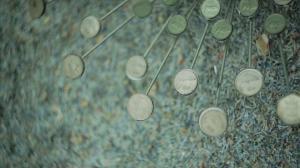The Billion Euro House is a short film from Dublin, Ireland and was directed by Alec Moore. It is a micro documentary / artist statement piece for and of Frank Buckley’s Billion Euro House project where he has, as the project title indicates, built a house out of shredded currency.
While I am used to people speaking with Irish accents, I would advise those that are not to watch this video through a second time to be sure they caught everything. A single watch takes about two and a half minutes, so watching it twice is no bother.
There is a fair amount happening right off in this ,from the first second. The music cue hits first, then the image of coins on this long metal sticks – they appear from the angle to be the bottom of a clock perhaps. The freeze frame of this is rather nice actually, and would make a nice photograph.
From there the image does a pan across these coins, where the ones closest to the middle of the frame are a bit out of focus, where the ones around the top edge are more in focus. I think that this helps make the pan seem very fluid, in that the in-focus parts act as a central point for the coins to appear to “swing” from during the pan.
Then Frank starts to speak, saying “I had my own difficulties at the time”, before it cuts to his face for the rest of the voice over. I think this was very purposefully done, as money is a common problem that many people have to deal with, which gives the audience an automatic in, while also letting them emphasis with Frank before ever seeing him.
As Frank continues to speak the camera jump cuts to several appears around the building, using a heavy amount of shallow depth of field as it does to further abstract the money, as an attempt to get the viewer to perhaps challenge their preconceived notions of what money is and does with how it is being used in this situation.
Later on, as Frank is shown building a section of wall, his voice over comments “What is the Euro? What is currency? Who gets it? What do they do with it?”. These are rather important questions at this time, as several countries are facing economical problems. People tend to think of money as this very powerful thing, but really, as Frank shows in this gallery space, is that money is only as valuable as we think it is. Belief in power is itself a powerful thing, and perhaps people should not forget that so easily.
There are however, a few pan that happen during this part of the voice over (around 1:50) that I feel go a smidgen too fast, as they are suppose to be showing a wider view of the space, but due to their speed one can hardly get a good look at anything or a sense of space in those moments. This is corrected near the end, when there is a straight on shot of one of the hallways, and another of a larger room, in the house that are used as gallery space, but still, it would have been nice to see more of the rooms.
Over all, I think it brings up some solid ideas worth thinking on.
You can find out more about the Billion Euro House on their website: http://billioneurohouse.com/
And the short film can be watched below, or on vimeo:
